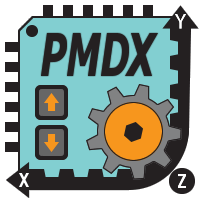1
SmartBOB controllers and dedicated accessories / Re: Connecting Tool Setter Probe to Patriot VFD
« on: October 16, 2025, 01:50:14 PM »
Without more info on your probing device, I can only offer generic advice.
Input terminal 4 on the G540 maps to pin 13 on the DB-25 of the PMDX-411.
If you use a wire jumper on the G540 Main Terminal Block to test this input by temporarily shorting terminal 4 to terminal 12 (power supply ground of the G540) you should be able to control the indicator in the Show Real-Time Input/Output Status window available in the Configure>Plugins>PMDX-SmartBOB control panel window. Once you get this working, proceed to Mach4 and use Configure>Control, select the Input Signals tab. Scroll way down to find Probe 1 in the left column. Then in the Mapping Enabled column next to Probe 1 click to change the Red X to a Green Check Mark. In the Device column click on the box and then the down arrow to list devices. Select SmartBOBUSB. In the Input Name column click in the box and then the down arrow to list available inputs on the SmartBOBUSB. Inputs that have already been assigned to other functions will not be in the list. Select pin 13 assuming it is available. Apply and exit. Now you should be able to see the Probe 1 status in the Mach4 diagnostics screens.
Input terminal 4 on the G540 maps to pin 13 on the DB-25 of the PMDX-411.
If you use a wire jumper on the G540 Main Terminal Block to test this input by temporarily shorting terminal 4 to terminal 12 (power supply ground of the G540) you should be able to control the indicator in the Show Real-Time Input/Output Status window available in the Configure>Plugins>PMDX-SmartBOB control panel window. Once you get this working, proceed to Mach4 and use Configure>Control, select the Input Signals tab. Scroll way down to find Probe 1 in the left column. Then in the Mapping Enabled column next to Probe 1 click to change the Red X to a Green Check Mark. In the Device column click on the box and then the down arrow to list devices. Select SmartBOBUSB. In the Input Name column click in the box and then the down arrow to list available inputs on the SmartBOBUSB. Inputs that have already been assigned to other functions will not be in the list. Select pin 13 assuming it is available. Apply and exit. Now you should be able to see the Probe 1 status in the Mach4 diagnostics screens.


